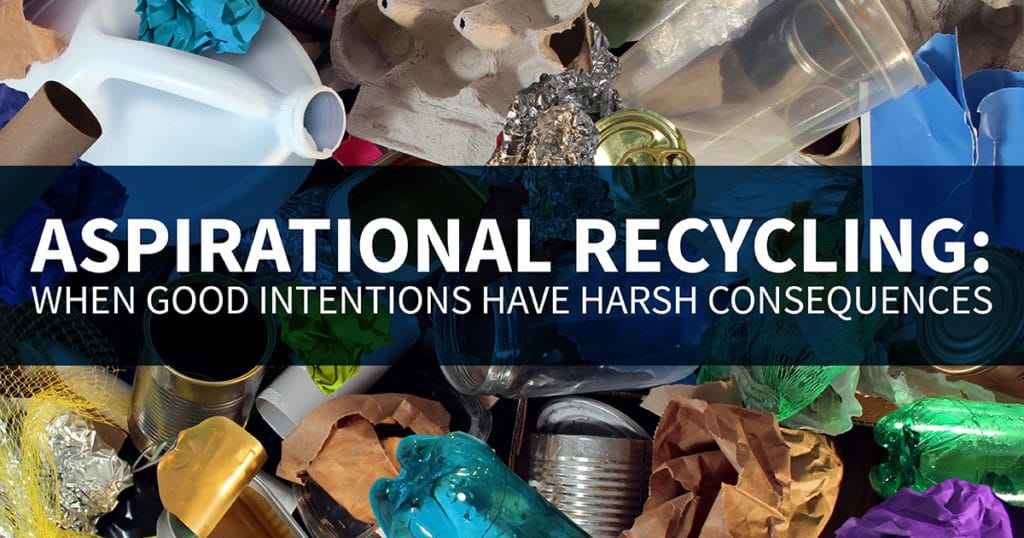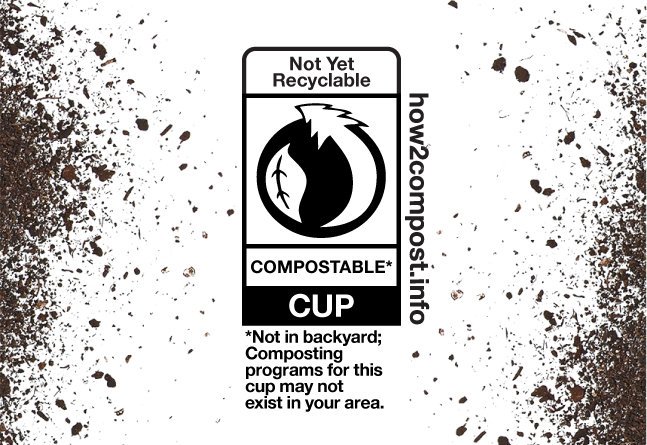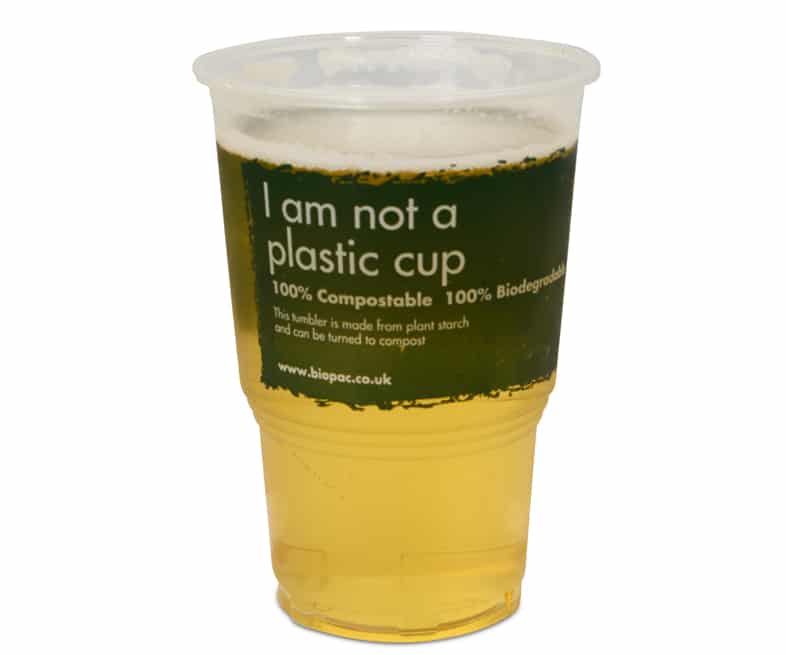Much has been written about the problems associated with packaging beer in those flimsy plastic film six-pack rings or rigid snap-on can carriers, neither of which are curbside recyclable. As for the other plastic culprit in craft beer – festival and beer garden cups – that presents another problem, and one that’s not as easily solved or avoided.
Practically every brewery that serves beer for outdoor consumption or pours samples at a festival in disposable cups is contributing to the mountain of single-use waste that’s piling up every year. And unfortunately those compostable* cups, typically made from corn starch, that beer pourers or festival volunteers brag about are only helpful if they get collected separately from garbage or recycling and sent to a commercial composting facility. Very few venues appear to be doing that.
If put into recycling bins, which they almost always are, they actually contaminate the recycling process. If they end up in a landfill, it could take 100 years or more before they eventually break down, if at all. Compostable* cups may seem like an easy solution, but the devil is always in the details. And it highlights the unintended consequences that occur when the all-important concepts of REDUCE and Reuse are ignored in favor of jumping straight to recycle or compost. The former are a viable solution to our over consumption of single-use items while the latter is simply not sustainable.

Confusion over the difference between recyclable, compostable, photodegradable or biodegradable only adds to the problem, and the absence of separate streams and proper signage for disposing of various products at beer gardens and festivals isn’t helping. That’s probably because the infrastructure for sorting and processing such innovative compostable* products just isn’t there yet. And judging from the lack of recycling capacity in much of the world, it’s not likely to improve any time soon. Ultimately, the best destination for most compostable* bioplastics at this point is in the trash.
As reported by the LiveScience website, what exactly happens to compostable materials when they end up in landfills is up for debate. Commonly used compostable* material such as those corn starch PLA (which stands for polylactic acid) cups sometimes break down anaerobically to release methane, a greenhouse gas about 30 times more potent than carbon dioxide. Another study found that PLA sometimes doesn’t break down at all in a landfill, meaning that cups, straws, and other items marketed as compostable* wind up in the trash but don’t actually compost there either.
“In theory, Peter Canepa, a life cycle assessment specialist with the Department of Environmental Quality in Oregon told LiveScience, “these materials should [be collected separately and go to] a commercial composting facility, but the majority of dedicated composting facilities in the U.S. only accept yard trimmings and similar organic refuse.” Reason being that compostable* bioplastic items, which are chemically modified, often don’t result in the kind of nutrient-rich soils desired for gardening or farming. Commercial composters in at least one state have actually published a report on why they don’t want compostable* packaging and serviceware ending up in their facilities at all.

Admittedly, it’s a conundrum for those breweries, festivals, and outdoor events trying to do right by the environment, especially when sustainable solutions such as using proper glassware or allowing patrons to bring their own refillable cups can be more costly and less convenient. One alternative, the new Ball Aluminum Cup, promises to be a better option because it’s infinitely recyclable, though not yet practical for most small businesses because it’s currently more expensive than plastic. The cups are far more durable than plastic, however, and therefore could be washed and reused multiple times to make the economics more favorable, which is likely to happen anyway as production scales up and the price comes down.
Ultimately, environmentally conscious consumers will need to voice their opinions by putting their money where their beer-drinking mouths are. Fortunately research indicates that many beer purchasers (and not just craft drinkers) are willing to pay a little more for sustainably produced, packaged, and served beer. The next step is to prioritize the environment ahead of convenience when choosing where to indulge. That means voting for eco-friendly businesses with their wallets, and responding to business-as-usual establishments with their feet – by deciding to go elsewhere.![]()
![]()
*The term compostable appears with an asterisk throughout this blog post because of the disingenuous marketing that often accompanies it, especially as it relates to bioplastics. It’s an unfortunate development that environmentalists refer to as greenwashing. Long story short, as this report makes clear, the vast majority of bioplastic cups, cutlery, take-away containers, etc., will degrade in the environment, land or sea, just like traditional plastic. In other words, they only degrade into smaller particles called micro plastics which frequently leak into the environment and pollute our oceans, soil, and air quality. They aren’t truly organic material and therefore aren’t truly compostable.
Related: Breweries Worldwide Increasingly Ditching Plastic Can Carriers for Eco-Friendlier Ones



can you suggest a cup material that is the least harmful to the environment. i am looking for disposable cups to use in my store.
Hi Ginger: I wish there was such a thing as a disposable, single-use cup that wasn’t harmful to the environment, but such an item does not exist. The LEAST harmful option at this point is arguably the Ball aluminum cup, which is both reusable (if desired) and easily recyclable everywhere. Clear (but not colored) plastic cups would be the next option, assuming they make their way to a recycling bin after use. So-called compostable cups are only useful if they are actually collected separately from other disposables and sent to a commercial composting facility. Neither paper nor Red Solo cups are accepted by standard curbside recycling programs and are therefor the worst option.
Thank you for sharing this info. It is also important to note that the corn used to make the cups is probably GMO and highly pesticide and the process to make a cup from corn is very energy consumptive.
Thanks for the additional insight Kyla, our industrialized food system and its reliance on chemical fertilizer, pesticide, etc. is a real concern.
Hello, thanks for this information, it’s a very confusing marketplace. What about plain old paper cups? Or is their plastic/waxy coating a problem?
Hey Erica: It is a confusing marketplace, especially because there is so much “greenwashing” these days from marketers that want to convince environmentally conscious consumers that everything can be greened. In reality it cannot. Single-use of virtually every material, even the beloved aluminum beer can, is unsustainable. As for “paper” cups, unfortunately they are not recyclable either because of the polymer or waxy coating. At this point, the two best solutions are to either stick with glass (and just be very diligent/cautious), or switch to stainless steel or the Ball Aluminum Cup (which is both reusable and highly recyclable). If I ran a brewery with outdoor space I would use the Ball Aluminum Cup, collect them separately (preferably at the bar) and wash and reuse them multiple times. They provide a great drinking experience and if reused would be comparable to the cost of plastic.
I’m trying to purchase cups for single use. What are my best options?
Thank you!
Hi Jan: The truth is, there really isn’t a sustainable option when it comes to single use, regardless of material. I would encourage you to consider reusables, even if they can’t be washed immediately. There are durable and affordable reusable plastic cups that could be collected and washed later for reuse, and companies like Cup NextGen or CupZero that actually provide a cup supply and washing service. Short of that, try using the Ball Aluminum Cup which costs a little bit more than single-use plastic cups but is more durable, washable and reusable, and much more likely to get recycled if you can’t wash and reuse them (some customers will even take them home to reuse). The absolutely worst option is colored plastic.
Can you give me an opinion on the Tossware “POP” line (https://www.tossware.com/collections/pop)? It claims to be made with (some) recycled material, and to be recyclable … and maybe reusable? Better or worse than the Ball Aluminum cups?
Hi Alex:
Sorry for the slow reply. I have never held the product in my hands, but from what I can tell on the website it seems like it’s intended to be reusable. If durable enough, that would be far better than single-use plastic or compostable options. I’m not a big fan of plastic in the dishwasher, however. I think I would favor the Ball Aluminum Cup, assuming you are going to collect, wash, and reuse them. I would venture a guess that they are probably just as durable as the Tossware POP. In addition, they are now made from 90% recycled content and are among the most recycled materials in the world because they actually retain their value, have end-markets, and are universally accepted in recycling programs. Hope that helps. Cheers
Thank you for all the information. I’m not a brewery owner, but I am an owner of a coffee shop. We’re not open yet, and I’m trying to decide the best way to go about to-go cups. I’m extremely frustrated, and I’m trying my best to make the best ethical and environmentally friendly decisions, also budget-friendly because we are a very new business. Do you have any suggestions or advice?
Hi Grace: You’re not alone with your frustration. Manufacturers are notorious for greenwashing their single-use products. If you are willing to share your location, I can likely provide some insight as to what your potential options are, including the possibility of a refillable cup program. There might even be grant funding available for a reuse or waste reduction pilot of some kind. Happy to brainstorm ideas with you.
We’re located in Gladstone, Michigan – really isolated from some larger commercial distribution areas. I’ll take any ideas you have! I’ve recently been researching the Huskee Cup program – sounds like it could be an option in the future. I’m also throwing around the idea of doing a discount for people who come in with their own cups, but there are a few concerns from my brother (owner as well) who thinks that could be a health code risk. Programs like the Huskee cup help solve that because the cups you take in can get washed and the customer is given a clean reusable cup of the same type.
Hi Grace:
The Huskee Cup looks really cool, and they have a Huskee Swap program, though I don’t know what the economics of it are. Probably worth finding about, though. I also see that there is a Michigan group called NextCycle that offers technical assistance (that’s a fancy term for consulting, usually free). I sent them an email to see if they have any suggestions and will let you know if I hear back. As a last resort, I think the bring your own cup idea could work, especially if you posted a visible sign with clear expectations regarding a cleanliness requirement. Or if you wanted to get a little crazy, maybe it’s a swap-a-cup sort of program. Consumer drops one off (that gets washed in your dish washer whenever) and you provide them with one that’s already clean. You would just need to think about cup sizes being similar. A novel idea that’s maybe worth a try. Let’s stay in touch.